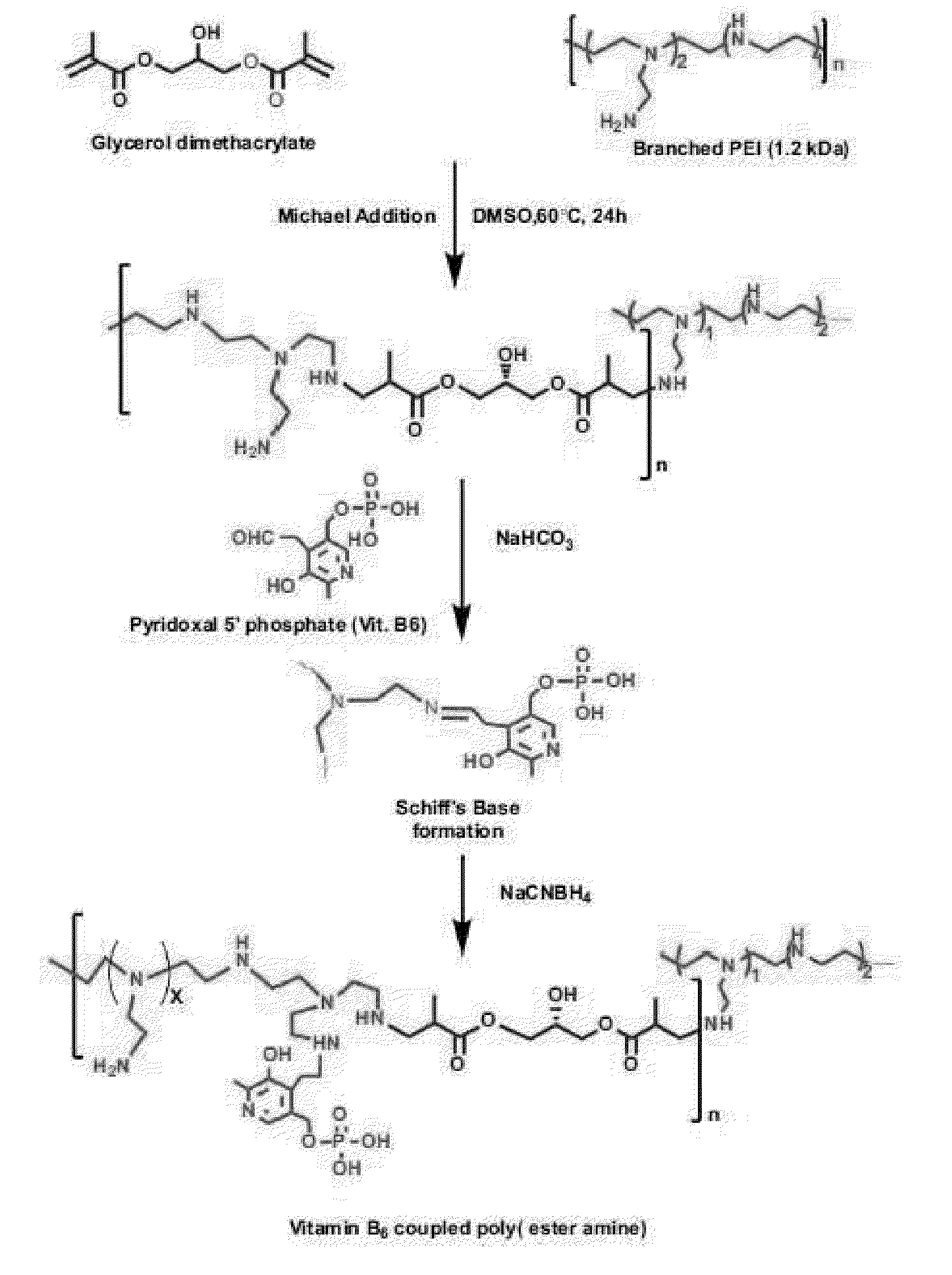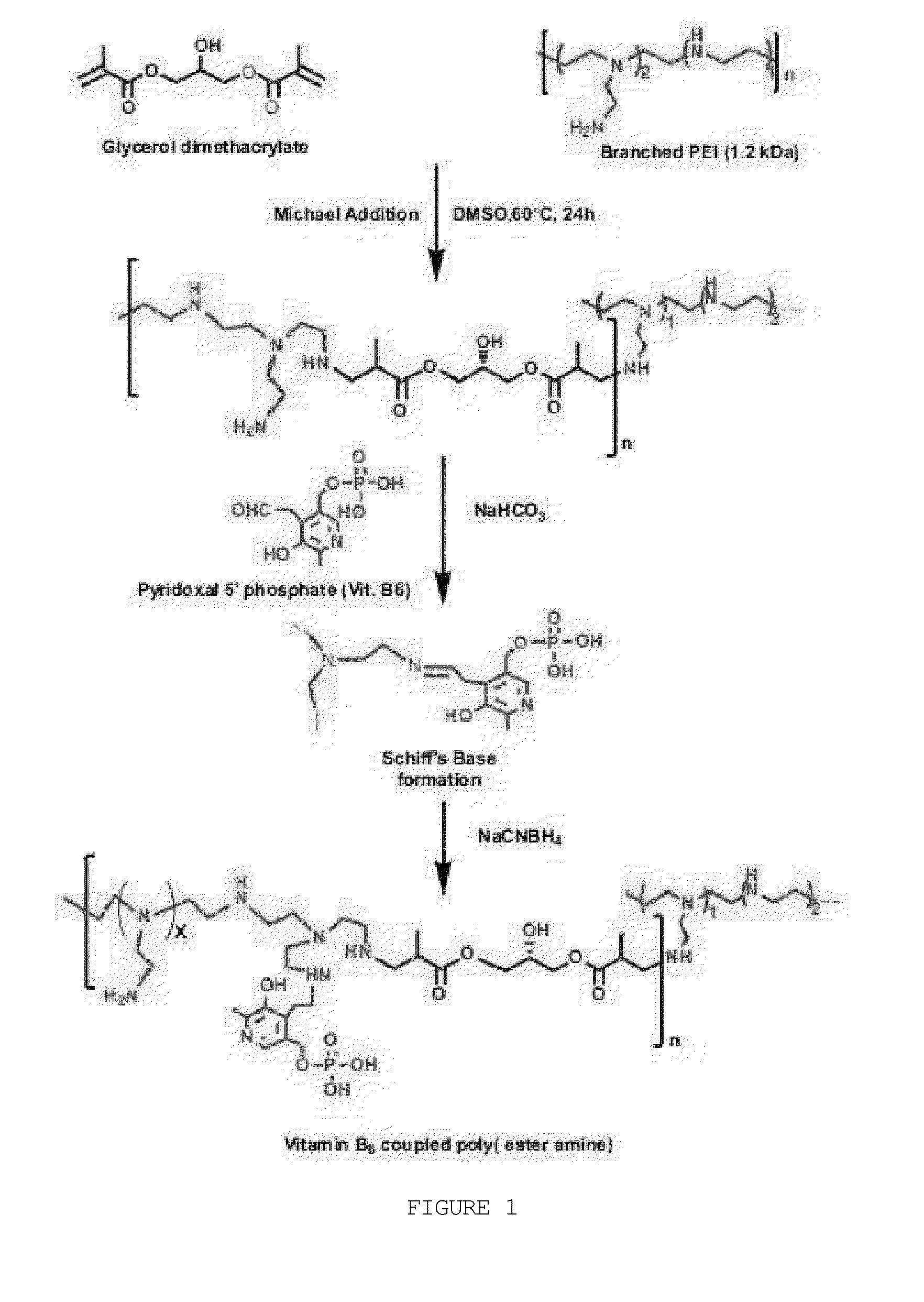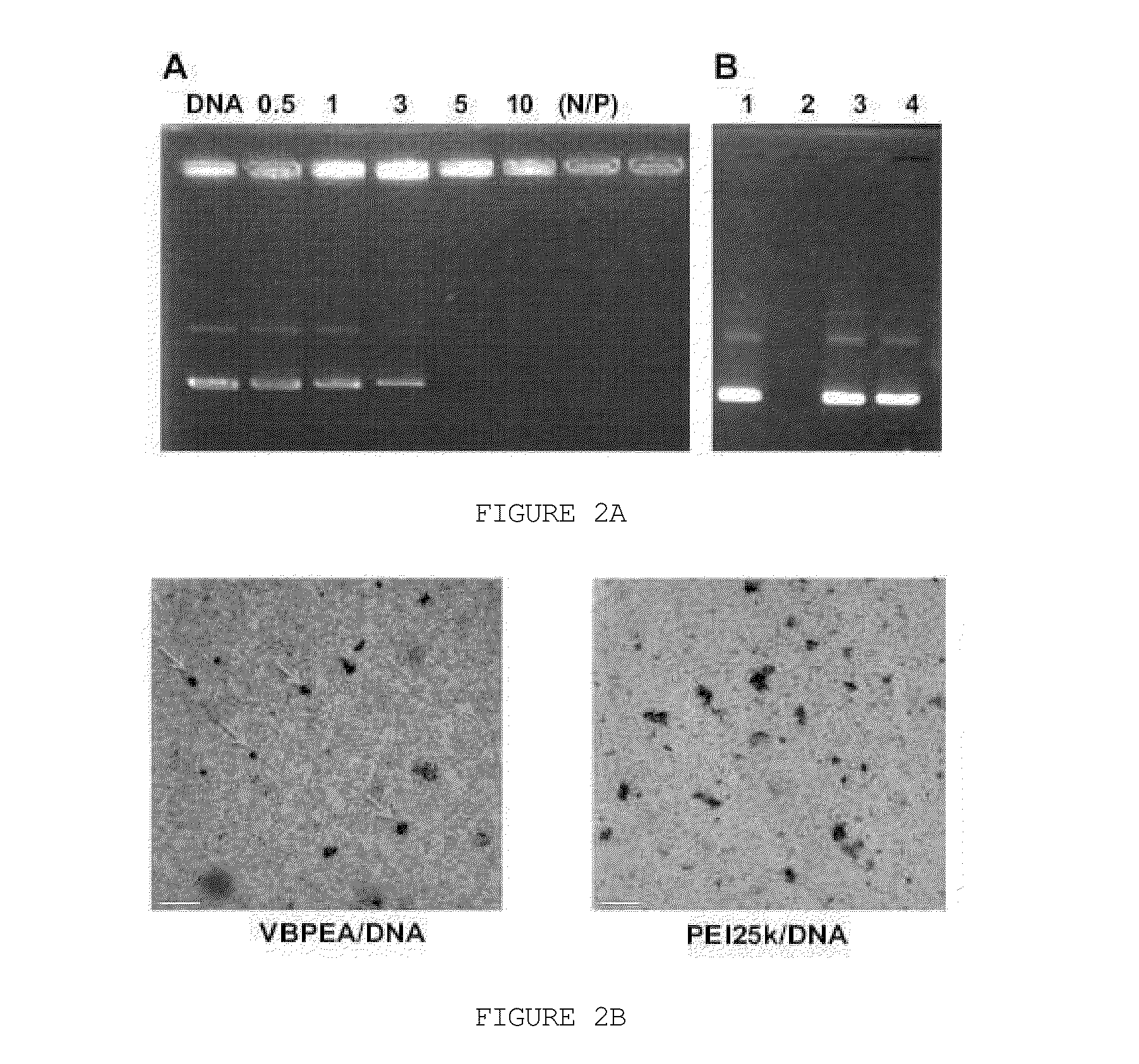Vitamin b6-coupled poly(ester amine) as gene carrier and application in cancer gene therapy
a technology of ester amine and vitamin b6, which is applied in the field of vitamin b6coupled poly (ester amine) as a gene carrier, can solve the problems of limited dna capable of being received therein, low efficiency of dna introduction into cells, and inability to carry dna in vivo, and achieves low cytotoxicity, high gene delivery rate, and high in vivo transfection efficiency
- Summary
- Abstract
- Description
- Claims
- Application Information
AI Technical Summary
Benefits of technology
Problems solved by technology
Method used
Image
Examples
examples 1
Reagents and Materials Used
[0087]In the present invention, the vitamin B6-coupled poly(ester amine) (VBPEA) gene carrier of the present invention was prepared, and the following materials and reagents were used in the following examples and experimental examples: bPEI (branched poly(ester imine), Mn: 1.2 k and 25 k), DMSO (dimethyl sulfoxide), PLP (pyridoxal 5′-phosphate), NaCNBH4 (sodium cyanoborohydride), genistein, Chlorpromazine, methyl-β-cyclodextrin, bafilomycin A1, MTT (3-(4,5-dimethyl thioazol-2-yl)-2,5-diphenyl tetra-zolium bromide) reagent and 4′-4′-deoxylpyridoxine hydrochloride were obtained from Sigma (St. Louis, Mo., USA). Moreover, a firefly (Photonus pyralis) luciferase-encoding luciferase reporter, a pGL3-vectoor and an enhancer were obtained from Promega (Madison, Wis., USA). GFP (green fluorescent protein) gene was obtained from Clontech (Palo Alto, Calif., USA). Confocal microscopic analysis was performed using TRITC (tetramethylrhodamine isothiocyanate) and YOYO...
example 2
Preparation of Vitamin B6-Coupled Poly(Ester Amine) Gene Carrier
[0088]The vitamin B6-coupled poly(ester amine) (VBPEA) gene carrier according to the present invention was synthesized according to the Michael addition reaction that is a slight modification of the method described in Arote R B, et al., Bioconjug. Chem. 2009, 20(12): 2231-41) (FIG. 1).
[0089]In brief, the VBPEA gene carrier was prepared by a two-step reaction comprising cross-linking low-molecular-weight bPEI with glycerol dimethacrylate (GDM) to prepare PEA (poly(ester amine), and coupling B6 (pyridoxal 5′-phosphate (PLP) to the prepared PEA (poly(ester amine). The detailed process is as follows.
[0090]2-1: Step of Preparing PEA
[0091]PEA was prepared by the Michael addition reaction between low-molecular-weight bPEI (1.2 k) and GDM. Specifically, each of GDM and low-molecular-weight bPEI was dissolved in anhydrous methanol, the low-molecular-weight bPEI solution was slowly added to the GDM solution at 60° C. and a const...
example 3
Analysis of Properties of Vitamin B6-Coupled Poly(Ester Amine) / DNA Complex
[0100]3-1. DNA Condensation Capability of VBPEA
[0101]One of the most properties of gene carriers is the capability to condense plasmid DNA by interaction therewith. Accordingly, the DNA condensation capability of the vitamin B6-coupled poly(ester amine) (VBPEA) prepared in Example 2 was analyzed by a gel retardation assay.
[0102]Specifically, VBPEA was mixed with a pGL3 plasmid (5.3 kb, Promega) at various molar ratios (N / P ratios) of 0.5, 1, 3, 5 and 10, and the mixture was adjusted with a total volume of 20 ul with autoclaved water. Each of the solutions was lightly vortexed and incubated at room temperature for 30 minutes, and 1× loading dye (Biosesang, Korea) was added thereto. Then, each of the reaction solutions was electrophoresed (100 V) on 0.8% agarose gel, and the mobility of DNA was observed under UV light. As a control, the pGL3 plasmid alone was used without reacting with VBPEA.
[0103]As a result, a...
PUM
| Property | Measurement | Unit |
|---|---|---|
| weight-average molecular weight | aaaaa | aaaaa |
| weight-average molecular weight | aaaaa | aaaaa |
| particle size | aaaaa | aaaaa |
Abstract
Description
Claims
Application Information
 Login to View More
Login to View More - R&D
- Intellectual Property
- Life Sciences
- Materials
- Tech Scout
- Unparalleled Data Quality
- Higher Quality Content
- 60% Fewer Hallucinations
Browse by: Latest US Patents, China's latest patents, Technical Efficacy Thesaurus, Application Domain, Technology Topic, Popular Technical Reports.
© 2025 PatSnap. All rights reserved.Legal|Privacy policy|Modern Slavery Act Transparency Statement|Sitemap|About US| Contact US: help@patsnap.com



